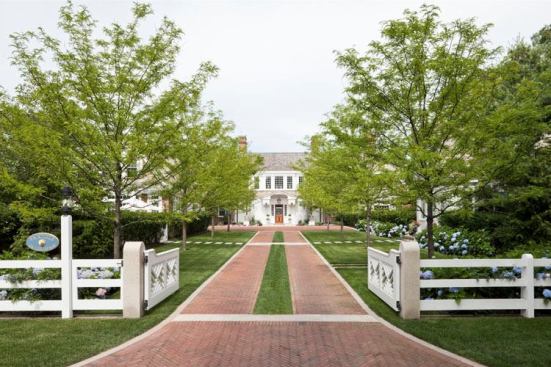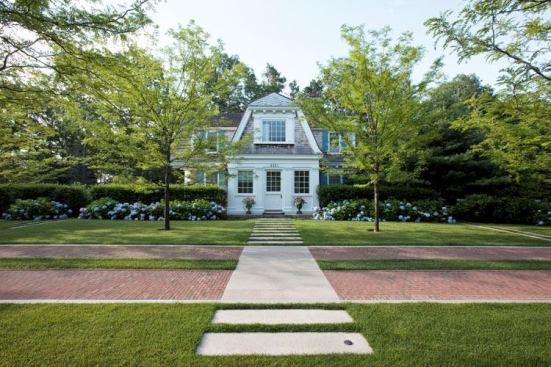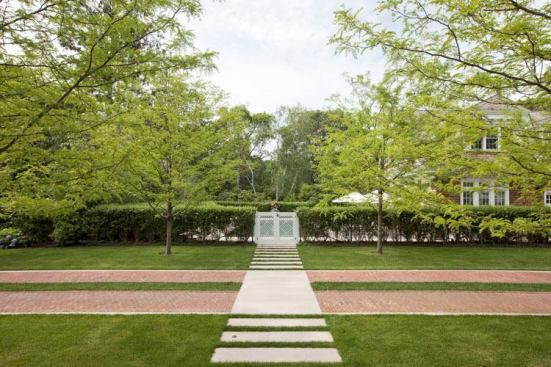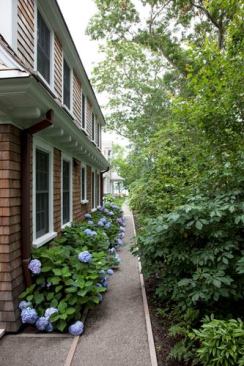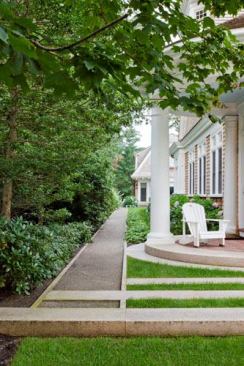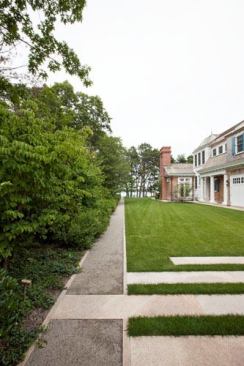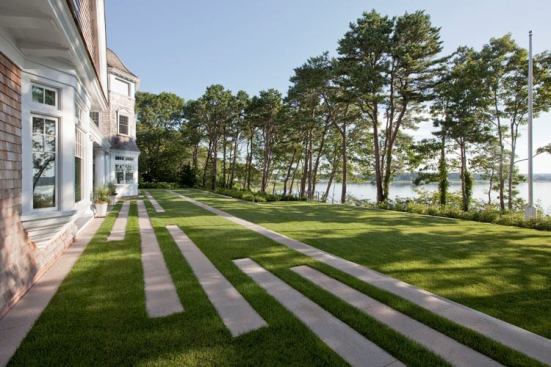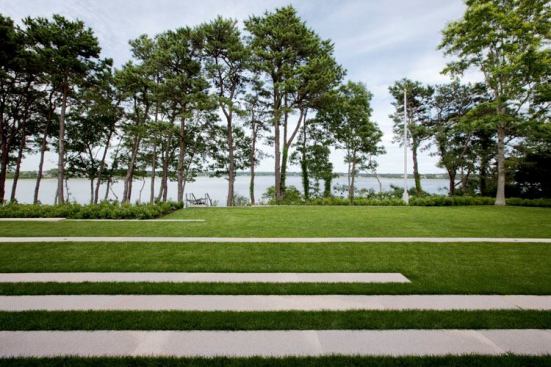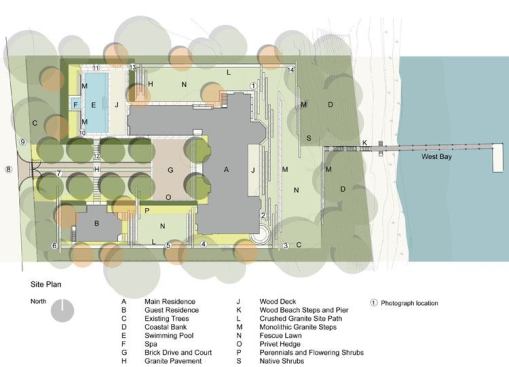Charles Mayer Photography
Environmental regulations made permeable landscaping a requireme…
A thoughtfully designed house may enhance the landscape at large, but the act of constructing it wreaks terrible havoc on the soil. Heavy earth-movers and delivery trucks converge on the property, compacting the compacting the ground and squeezing out air pockets that encourage plant roots to grow deep. That’s bad news for water conservation, since the channels by those long roots carry rainwater down into the earth, where it tops up underground aquifers. Adding insult to injury, after construction, large portions of the lot often are seeded with shallow-rooted turf grass and paved with terraces and paths. With so much impermeable surface, storm-water gushes down the driveway into the street, taking with it street, taking with environmental pollutants. Storm drains are overloaded, and fresh water ends up miles away in a salty ocean or bay. Water shortages have been an issue for so long that people now do their part to plant drought-tolerant native species, and the thirsty green lawn is no longer the suburban prize it once was. Yet permeable landscaping is just starting to catch on as an ecologically sustainable gardening practice. Basically, it means increasing the percentage of landscaped areas and permeable surfaces to prevent rainwater from leaving the site.
What Lies Beneath A permeable landscape starts with improving the soil’s porosity, or air space. That’s accomplished by drilling into the soil and filling the holes with leaf compost or aerating the lawn by pulling out plugs with a machine, says Karla Patterson Lynch, manager of horticulture education at The Morton Arboretum in Lisle, Ill. A better alternative is to minimize the lawn area in favor of plantings that send down deep roots, and a good place to find them is the local native-plants nursery. “Here in the Midwest, native prairie plants have root systems that go 10 feet to 15 feet into the soil,” Lynch says, “whereas turf goes down 6 inches, if you’re lucky.”
Ideally, vegetated areas should include a combination of ground covers, perennials, woody shrubs, and trees, since layers of foliage disperse water from a downpour. “Rain hits all the different leaves and slows down, which allows the soil to absorb it better,” Lynch explains. “Trees can absorb thousands of gallons of water a day and function like a giant umbrella to slow down and deflect water.”
Hard surfaces are practical, though, and they tie the house and garden together. Fortunately, the options for earth-friendly pavement have grown exponentially in recent years. One approach is to use porous materials engineered to allow water to filter through—such as permeable asphalt, permeable interlocking concrete-based pavers, and honeycomb modules with planted voids that provide a structural parking surface. Another is to install natural materials such as clay bricks and stone without mortaring them in place. Water spills into the joints and down into a drainable construction base—typically coarse ¾ -inch gravel topped with a layer of 3/8 -inch gravel and a sand base. The depth of each layer depends on the soil type and how much weight it must bear.
“Driveways need roughly a foot of ¾ -inch stone, 4 inches of 3/8 -inch stone, and 1 inch of sand—basically a leveling course for the brick,” says Bob Marzilli, owner of R.P. Marzilli & Co., a landscape contractor in Medway, Mass. He adds that, without the benefit of interlocking pavers, it takes a skilled craftsman to create uniform joints on large surfaces like driveways. A sturdy driveway edge, such as vertical bricks in a concrete haunch, helps keep the outline crisp.
Landscape architect Isabelle Greene of Isabelle Greene & Associates, Santa Barbara, Calif., is fond of paved driveway strips with a grass or thyme median. And as a versatile masonry alternative, she says crushed granite has a nice way of packing, making it easy to walk and drive on. “I’m not a neatnik and I generally don’t believe in edging,” Greene says. “When I use a crushed granite path next to plants, I let the plantings encroach so there’s a soft edge.”
Joseph Wahler, senior landscape architect at Stephen Stimson Associates Landscape Architects in Falmouth, Mass., speced crushed granite walkways for a recent project on Cape Cod. The 1-inch-deep crushed granite was installed over an 8-inch base of ¾ -inch stone. A matching flush granite curb, 3 inches wide and 12 inches deep, creates a solid permanent edge that suits the estate’s formal layout. “You want to spec crushed granite rather than decomposed granite, which uses a chemical process that can darken the color,” Wahler advises. “Color is chosen based on the parent material.”
Permeability need not be sacrificed for party-friendly surfaces either. The Cape Cod property included a long, elegant driveway with dry-laid brick wheel strips in a grassy median, and behind the house, a lawn terrace artfully fortified with a series of flush, 6-foot-long-by-18-inch-wide granite strips. In this case, what lay beneath the surface was of equal concern. “If our clients are going to use a lawn area for big events, or if it’s near the house and they want to use it as an indoor-outdoor connection, we’ll work with a soil consultant to make sure the soil drains quickly and resists compaction,” he says. Structural Soil
Soil scientist John C. Swallow, Ph.D., a co-principal of Pine & Swallow Environmental in Groton, Mass., works with builders and landscape architects to gauge the permeability of existing soils and create a mix that supports an area’s specific use. For example, a sand-based soil layered with organic matter keeps pervious pavement structurally true, while also encouraging the vigorous growth of nearby plants by allowing water and air to circulate freely. By contrast, a generic coarse soil is a sufficient sub-base for permeable driveways and parking courts without adjacent trees and shrubs.
Either way, “you want to provide a reservoir for water to accumulate under the pavers to maximize the opportunity for deep infiltration,” Swallow explains. “In both cases you must have structural integrity, so the ground doesn’t settle. The difference between the two is the gradation of coarseness and the percentage of organic matter.”
The government anticipates water shortages in at least 36 states in the next few years, and some jurisdictions, such as Santa Monica, Calif., already mandate the reduction of urban runoff from newly developed single-family parcels. It’s wise to inform custom home clients about permeable landscape principles now, before they’re forced to comply.
